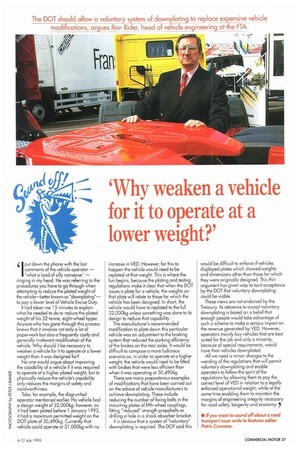'Why weaken a vehicle for it to operate at a lower weight?'
Page 49

If you've noticed an error in this article please click here to report it so we can fix it.
I 4 put down the phone with the last comments of the vehicle operator —
"what a load of silly nonsense" — ringing in my head. He was referring to the procedures you have to go through when attempting to reduce the plated weight of the vehicle—better known as "downplating"to pay a lower level of Vehicle Excise Duty.
It had taken me 15 minutes to explain what he needed to do to reduce the plated weight of his 32-tonne, eight-wheel tipper. Anyone who has gone through this process knows that it involves not only a lot of paperwork but also a frequently costly and generally irrelevant modification of the vehicle. Why should it be necessary to weaken a vehicle for it to operate at a lower weight than it was designed for?
No one would argue about improving the capability of a vehicle if it was required to operate at a higher plated weight, but to physically reduce the vehicle's capability only reduces the margins of safety and roadworthiness.
Take, for example, the disgruntled operator mentioned earlier. His vehicle had a design weight of 32,000kg: however, as it had been plated before 1 January 1993, it had a maximum permitted weight on the DOT plate of 30,490kg. Currently that vehicle could operate at 31,000kg with no increase in VED. However, for this to happen the vehicle would need to be replated at that weight. This is where the fun begins, because the plating and testing regulations make it clear that when the DOT issues a plate for a vehicle, the weights on that plate will relate to those for which the vehicle has been designed. In short, the vehicle would have to replated to the full 32,000kg unless something was done to its design to reduce that capability. The manufacturer's recommended modification to plate down this particular vehicle was an adjustment to the braking system that reduced the parking efficiency of the brakes on the rear axles. It would be difficult to compose a mare ludicrous scenario as, in Order to operate at a higher weight, the vehicle would need to be fitted with brakes that were less efficient than when it was operating at 30,490kg. There are many preposterous examples of modifications that have been carried out on the advice of vehicle manufacturers to achieve downplating. These include reducing the number of fixing bolts in the mounting plates of fifth-wheel couplings, fitting "reduced" strength propshafts or drilling a hole in a shock absorber bracket. It is obvious that a system of "voluntary" downplating is required. The DOT said this would be difficult to enforce if vehicles displayed plates which showed weights and dimensions other than those for which they were originally designed. This thin argument has given way to tacit acceptance by the DOT that voluntary downplating could be viable.
These views are not endorsed by the Treasury. Its reticence to accept voluntary downplating is based on a belief that enough people would take advantage of such a scheme to make a serious impact on the revenue generated by VED. However, operators mainly buy vehicles that are best suited for the job and only a minority, because of special requirements, would have their vehicles downplated. All we need is minor changes to the wording of the regulations that will permit voluntary downplating and enable operators to follow the spirit of the regulations by allowing them to pay the correct level of VED in relation to a legally enforced operational weight, while at the same time enabling them to maintain the margins of engineering integrity necessary for road safety, longevity and economy.




































































































